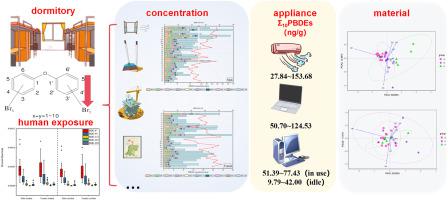当前位置:
X-MOL 学术
›
Environ. Pollut.
›
论文详情
Our official English website, www.x-mol.net, welcomes your feedback! (Note: you will need to create a separate account there.)
Polybrominated diphenyl ethers in student dormitory microenvironments: Concentrations, sources, and human exposure
Environmental Pollution ( IF 8.9 ) Pub Date : 2024-04-20 , DOI: 10.1016/j.envpol.2024.124010 Mantong Jin , Zhaoxuan Guo , Nanxi Ye , Liwei Sun , Jingjing Guo
Environmental Pollution ( IF 8.9 ) Pub Date : 2024-04-20 , DOI: 10.1016/j.envpol.2024.124010 Mantong Jin , Zhaoxuan Guo , Nanxi Ye , Liwei Sun , Jingjing Guo

|
Microenvironments, such as student dormitories, differ from general residential environments. They are characterized by small spaces, poor air circulation, high personnel densities, and electronic products, such as computers that are turned on for extended periods, leading to increased pollution concentrations. The limited space and poor air circulation reduce migration of contaminants, such as polybrominated diphenyl ethers (PBDEs), making it easier for PBDEs to accumulate. However, few studies have been conducted on small group dwellings, including student dormitory dwellings. We collected dust samples from student dormitories of a university to analyze the characteristics and traceability of PBDEs in dormitory microenvironments. The results showed that PBDE congeners were widely present in university dormitories and the order of median concentration of ∑PBDEs was as follows: male old-fashioned dormitory (273 ng/g) > female four-person dormitory (132 ng/g) > female two-person dormitory (132 ng/g) > male two-person dormitory (96.2 ng/g) > female old-fashioned dormitory (91.6 ng/g) > male four-person apartment (51.8 ng/g). BDE-209 was the most abundant PBDE congener, followed by BDE-47, and BDE-28. PBDEs were also found in typical electrical appliances, with higher concentrations in laptops than in desktops, and higher concentrations in desktops than in idle ones. According to Spearman correlation and Principal Component Analysis (PCA), we also found that boards and wallpaper materials were common sources of contamination in the microenvironment of student dormitories, and that female dormitories had more sources of PBDE emissions. Human exposure to PBDEs in students is below the US Environmental Protection Agency reference dose. Although exposure to PBDEs generated in dormitories does not pose a significant health risk, the potential hazards of PBDEs to the reagent environment remain to be investigated.
中文翻译:

学生宿舍微环境中的多溴二苯醚:浓度、来源和人体暴露
学生宿舍等微环境与一般居住环境不同。其特点是空间狭小、空气流通差、人员密度高、电脑等电子产品长时间开启,导致污染浓度增加。有限的空间和不良的空气流通减少了污染物的迁移,例如多溴二苯醚(PBDE),使得PBDE更容易积聚。然而,对包括学生宿舍在内的小型集体住宅进行的研究却很少。我们从某大学学生宿舍采集灰尘样本,分析宿舍微环境中PBDEs的特征及溯源。结果表明,大学宿舍中广泛存在PBDEs同系物,且ΣPBDEs中位浓度顺序为:男生老式宿舍(273 ng/g)>女生四人宿舍(132 ng/g)>女生两人宿舍(132纳克/克)>男生二人宿舍(96.2纳克/克)>女生老式宿舍(91.6纳克/克)>男生四人公寓(51.8纳克/克)。 BDE-209 是最丰富的 PBDE 同系物,其次是 BDE-47 和 BDE-28。典型电器中也发现了多溴联苯醚,笔记本电脑中的浓度高于台式机,台式机中的浓度高于闲置电器中的浓度。根据Spearman相关性和主成分分析(PCA),我们还发现板材和壁纸材料是学生宿舍微环境中常见的污染源,并且女生宿舍是PBDE排放的较多来源。学生体内多溴联苯醚的人体暴露量低于美国环境保护署的参考剂量。虽然接触宿舍产生的PBDEs不会造成重大健康风险,但PBDEs对试剂环境的潜在危害仍有待调查。
更新日期:2024-04-20
中文翻译:

学生宿舍微环境中的多溴二苯醚:浓度、来源和人体暴露
学生宿舍等微环境与一般居住环境不同。其特点是空间狭小、空气流通差、人员密度高、电脑等电子产品长时间开启,导致污染浓度增加。有限的空间和不良的空气流通减少了污染物的迁移,例如多溴二苯醚(PBDE),使得PBDE更容易积聚。然而,对包括学生宿舍在内的小型集体住宅进行的研究却很少。我们从某大学学生宿舍采集灰尘样本,分析宿舍微环境中PBDEs的特征及溯源。结果表明,大学宿舍中广泛存在PBDEs同系物,且ΣPBDEs中位浓度顺序为:男生老式宿舍(273 ng/g)>女生四人宿舍(132 ng/g)>女生两人宿舍(132纳克/克)>男生二人宿舍(96.2纳克/克)>女生老式宿舍(91.6纳克/克)>男生四人公寓(51.8纳克/克)。 BDE-209 是最丰富的 PBDE 同系物,其次是 BDE-47 和 BDE-28。典型电器中也发现了多溴联苯醚,笔记本电脑中的浓度高于台式机,台式机中的浓度高于闲置电器中的浓度。根据Spearman相关性和主成分分析(PCA),我们还发现板材和壁纸材料是学生宿舍微环境中常见的污染源,并且女生宿舍是PBDE排放的较多来源。学生体内多溴联苯醚的人体暴露量低于美国环境保护署的参考剂量。虽然接触宿舍产生的PBDEs不会造成重大健康风险,但PBDEs对试剂环境的潜在危害仍有待调查。



























 京公网安备 11010802027423号
京公网安备 11010802027423号